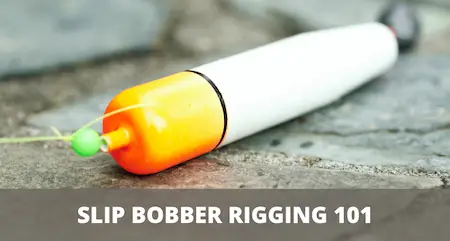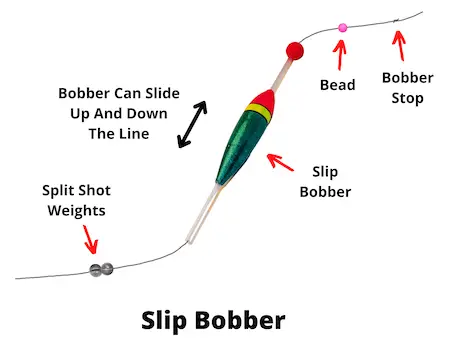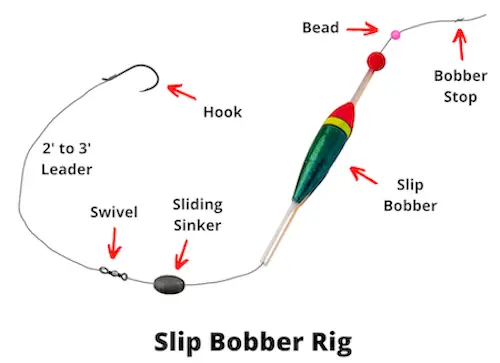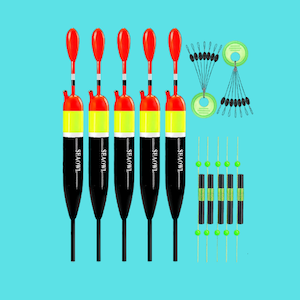Slip Bobber Rigging (Quickstart Guide)
UPDATED 03 NOVEMBER 2023
by Robert Ceran
The slip bobber rig is one of the most versatile fishing rigs there is, and in my opinion it is among the top 3 fishing rigs that every angler needs to know.
Millions of anglers use the slip bobber rig every season to catch a wide variety of different species, including all major freshwater game fish.
The power of the slip bobber rig lies in the fact that it enables anglers to fish at a wide range of depths, and to quickly change their fishing depth in response to different conditions.

In this article we’ll walk you through the basics of how to set up a slip bobber rig, what fish species to target with it, and how you can use it to catch more fish.
What is a slip bobber (and how does it work)?
A slip bobber is a floating device that can slide up or down the fishing line, and is usually rigged with a bobber stop above it, and a weight below it.

When cast out into the water, the weight pulls the line down through the slip bobber, causing the slip bobber to slide up the fishing line until it reaches the bobber stopper.
The power of a sliding float setup lies in the fact that you can easily adjust how deep or how shallow you fish, simply by changing the position of the bobber stop along your fishing line.
This enables you to use the same tackle to target a wide range of depths, making the slip bobber rig one of the most versatile fishing rigs available to anglers.
A slip bobber rig can be used to target pretty much any species of freshwater fish, as well as many saltwater fish in coastal regions.
And watching a slip bobber go down when a fish strikes is one of the most exciting moments for every angler.
Now that you have an idea how useful this rig is, let’s dive into the details and discuss the best slip bobber setup, and how to use it.
How to rig a slip bobber rig

Next we’ll cover how to rig a slip bobber. You’ll need the following tackle components for a slip bobber rig:
- Slip bobber (or sliding float)
- Main line (braid or monofilament)
- Leader line (fluorocarbon)
- Bobber stopper
- Plastic bead
- Swivel
- Sliding sinker (or split shot weights)
- Bait hook
How to set it up: Once you’ve assembled all the tackle you need, start by rigging a bobber stopper on to your main line.
The best choice of fishing line depends on your specific purposes, but either monofilament or braid are good choices, since they tend to float on top of the water, which is ideal for fishing with a float.
Next, thread a plastic bead onto your line below the bobber stop, and then thread on the slip bobber below the bead.
After the bobber is on your main line, thread a sliding sinker onto it below the bobber, and then tie the main line to a barrel swivel (or snap sw. Instead of a sliding sinker you can also add split shot sinkers below the float, depending on your preference (and on the size of your float).
Next, tie a fluorocarbon leader to the swivel, and measure out 2 to 3 feet of leader length, before tying a bait hook to the other end of the leader.
Fluorocarbon is the best choice for the leader, as it has the lowest visibility, and tends to sink in the water.
In general, you should keep your tackle as sensitive as possible, to avoid spooking the fish.
Finally, bait your hook, and you’re ready to cast out your slip bobber rig and start fishing!
How to use slip bobber stops
It’s essential to learn how to use bobber stoppers correctly for successful slip bobber fishing, since bobber stops determine how deep or how shallow you fish with your slip bobber rig.
And while you can tie your own bobber stops, it’s generally best to get ready-made bobber stops from the tackle store for your rigging needs, since they are generally cheap, as well as saving you a lot of time.
My favorite bobber stops are egg bobber stops, which come with a bead as part of the setup.
When rigging these, thread your fishing line through the wire loop of the bobber stop, and then slide the bead and bobber stop over the wire loop, and onto your line.
Once it’s on the line, you’ll be able to move the bobber stopper up and down by slowly sliding it, and thereby adjusting your fishing depth.
The great thing about using bobber stops is that they can readily glide through the eyes of your fishing rod during the casting process, and can even be reeled onto your fishing reel without any problems, which means you can set them at virtually any depth.
How much weight should you put on a slip bobber?
The amount of weight to put on a slip bobber depends on the size of your bobber and the size of your bait, but generally shouldn’t exceed 1/4 oz.
And when using a finesse slip bobber setup, it’s better to add just one or two small to medium split shot weights to your float.
The benefit of using a sinker is that it weighs down the slip bobber, which causes it to stand up straight in the water. It also allows you to cast further, by adding extra weight to the slip bobber rig.
In addition, if you’re using big live bait with your slip bobber (such as large suckers or shiners), the sinker helps to keep them at the right depth in the water column.
Finally, it also makes your whole rig more sensitive, as it allows a fish to pull your float underwater more easily when it takes the bait.
So try to choose a sinker that is heavy enough to fulfill all of those requirements, but without being too heavy either, so your float doesn’t sink.
If you do choose a weight that’s too big for your bobber, the whole rig will tend to sink, in which case you need to replace it with a smaller one.
What kind of fish can you catch with a slip bobber rig?
Due to its versatility, you can catch almost any type of freshwater fish with a slip bobber.
However, slip bobbers are most effective when used to target fish that are active inrelativeldy shallow water between 3 and 30 feet, and less effective for targeting fish that are active in deeper waters.
The most commonly caught fish with slip bobbers are:
- Catfish
- Walleye
- Bass
- Trout
- Steelhead
- Crappie
- Panfish
- Perch
- Common carp
Since this is a very diverse list of species, the gear, tackle, and bobbers used to target them also come in a wide range of shapes and sizes.
For example, you’ll need a much more sensitive slip bobber to catch panfish than you would for catfish.
Slip bobber fishing for catfish
Slip bobbers are great for targeting catfish, and while they can be used for any type of catfish, fishing with bobbers is most popular among channel catfish anglers.
When using a slip bobber rig for catfish, make sure you adjust the depth setting of your slip bobber so that your bait is presented within 1 to 3 feet above the bottom, which is where catfish are found most of the time.
Many catfish anglers like to use cut bait, prepared bait, and live bait when fishing for catfish with a slip bobber.
In most cases it also helps to use a treble hook instead of a single hook with a bobber rig for catfish, both in terms of getting the bait to stay on the hook, and in terms of getting a better hook up percentage when setting the hook after your float goes down.
Slip bobber fishing for walleye
By far the best way to use a slip bobber rig for walleye is with live bait such as minnows, nightcrawlers, and leeches.
Similar to catfish, you’ll want to adjust the depth of your rig so that your bait is presented within a couple feet above the bottom.
And while the traditional approach to fishing this rig for walleye was to cast it out in a promising location and then wait for walleye to come by and take the bait, a much more effective bobber fishing method called “power corking” has taken the walleye fishing world by storm over the past years.
Power corking for walleye consists of driving around with your boat until you mark a group of walleyes on your fish finder.
You then lower your bait to the right depth with a slip bobber (making sure you’re adjusted the bobber stop correctly), and wait a few minutes while watching your bobber to see if you get a bite.
If you don’t get a bite within 5 to 10 minutes, pull up your rig and continue searching until you find the next pod of walleyes.
The strength of power corking lies in the fact that you avoid dead time with no walleyes around, when you would be fishing your rig in empty water.
How to fish a slip bobber rig
The most common technique used with a slip bobber rig is to bait your hook and cast it out to an area where fish are feeding (such as the edge of a weed bed, or a drop off zone), followed by putting down your tackle and watching the float to detect any bites.
When you notice a bite, you grab your gear and reel in the slack line to set the hook and land the fish.
For many fish species, you can start by setting your depth to the middle of the water column, and then go either deeper or more shallow until you start getting bites.
When fish are heavily pressured, it’s generally best to use a more sensitive tackle setup in order to be able to detect shy bites.
Another great tactic is to use a slip bobber to present your bait just above the top of a weed bed, which is often where you’ll find suspended crappie, or trout cruising around in search of food.
This approach really plays to the strength of a slip bobber setup, since it allows you to suspend your bait at the right depth, while avoiding getting your tackle snagged on bottom cover.
A third method that works great for slip bobber fishing is drift fishing in rivers and streams, and is most commonly used to catch trout, steelhead and salmon.
This is another setting where a slip bobber rig really shines, since it allows you to adjust your fishing depth quickly and on the fly, while you systematically cover each location of a river before moving on to the next.
How deep can you fish with a slip bobber?
A slip bobber is most often used to fish at a maximum depth between 20 and 30 feet, but it can also be used in considerably deeper water of 60 feet or even deeper.
Theoretically, you can set your bobber stop along your line at any depth you like, but the biggest challenge when fishing in water that’s deeper than about 25 feet is targeting the right depth where the fish are active.
If you’re fishing in shallow water under 6 feet, it’s better to use a fixed bobber rig, such as the popping cork rig.
The best way to use a slip bobber rig in deep water is to fish it from a boat, and make use of a fish finder to pinpoint the depth you need to target.
When done correctly, you can use this strategy with live bait to target deep water species such as lake trout with a slip bobber rig.


